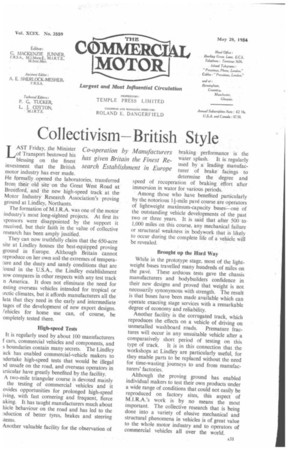Collectivism—British Style
Page 33

If you've noticed an error in this article please click here to report it so we can fix it.
LAST Friday, he Minister of Transport bestowed his blessing on the finest investment that the British motor industry has ever made. He formally opened the laboratories, transferred from their old site on the Great West Road at Brentford, and the new high-speed track at the Motor Industry Research Association's proving ground at Lindley, Northants.
The formation of M.I.R.A. was one of the motor industry's most long-sighted projects. At first its sponsors were disappointed by the support it received, but their faith in the value of collective research has been amply justified.
They can now truthfully claim that the 650-acre site at Lindley houses the best-equipped proving ground in Europe. Although Britain Cannot reproduce on her own soil the extremes of temperature and the dusty and sandy conditions that are !found in the U.S.A., the Lindley establishment low compares in other respects with any test track n America. It does not eliminate the need for esting overseas vehicles intended for tropical or trctic climates, but it affords manufacturers all the lata that they need in the early and intermediate tages of the development of new export designs. fehicles for home use can, of course, be ompletely tested there.
High-speed Tests It is regularly used by about 100 manufacturers f cars, commercial vehicles and components, and s boundaries contain many secrets. The Lindley ack has enabled commercial-vehicle makers to idertake high-speed tests that would be illegal Id unsafe on the road, and overseas operators in micular have greatly benefited by the facility.
A two-mile triangular course is devoted mainly the testing of commercial vehicles and it ovides opportunities for prolonged high-speed lying, with fast cornering and frequent, fierce aking. It has taught manufacturers much about hick behaviour on the road and has led to the :Auction of better tyres, brakes and steering ;terns.
Another valuable facility for the observation of braking performance is the water splash. It isregularly used by a leading manufacturer of brake facings to determine the degree and speed of recuperation of braking effort after immersion in water for various periods.
Among those who have benefited particularly by the notorious if pave course are operators of lightweight maximum-capacity buses—one of the outstanding vehicle developments of the past two or three years. It is said that after 500 to 1,000 miles on this course, any mechanical failure or structural weakness in bodywork that is likely to occur during the complete life of a vehicle will be revealed.
Brought up the Hard Way While in the prototype stage, most of the lightweight buses travelled many hundreds of miles on the pave. These arduous tests gave the chassis manufacturers and bodybuilders confidence in their new designs and proved that weight is not necessarily synonymous with strength. The result is that buses have been made available which can operate exacting stage services with a remarkable degree of economy and reliability.
Another facility is the corrugated track, which reproduces the effects on a vehicle of driving on unmetalled washboard roads. Premature fractures will occur in any unsuitable vehicle after a comparatively short period of testing on this type of track. It is in this connection that the workshops at Lindley are particularly useful, for they enable parts to be replaced without the need for time-wasting journeys to and from manufacturers' factories.
Although the proving ground has enabled individual makers to test their own products under a wide range of conditions that could not easily be reproduced on factory sites, this aspect of M.1.R.A.'s work is by no means the most important. The collective research that is being done into a variety of elusive mechanical and structural phenomena in vehicles is of great value to the whole motor industry and to operators of commercial vehicles all over the world.




































































































